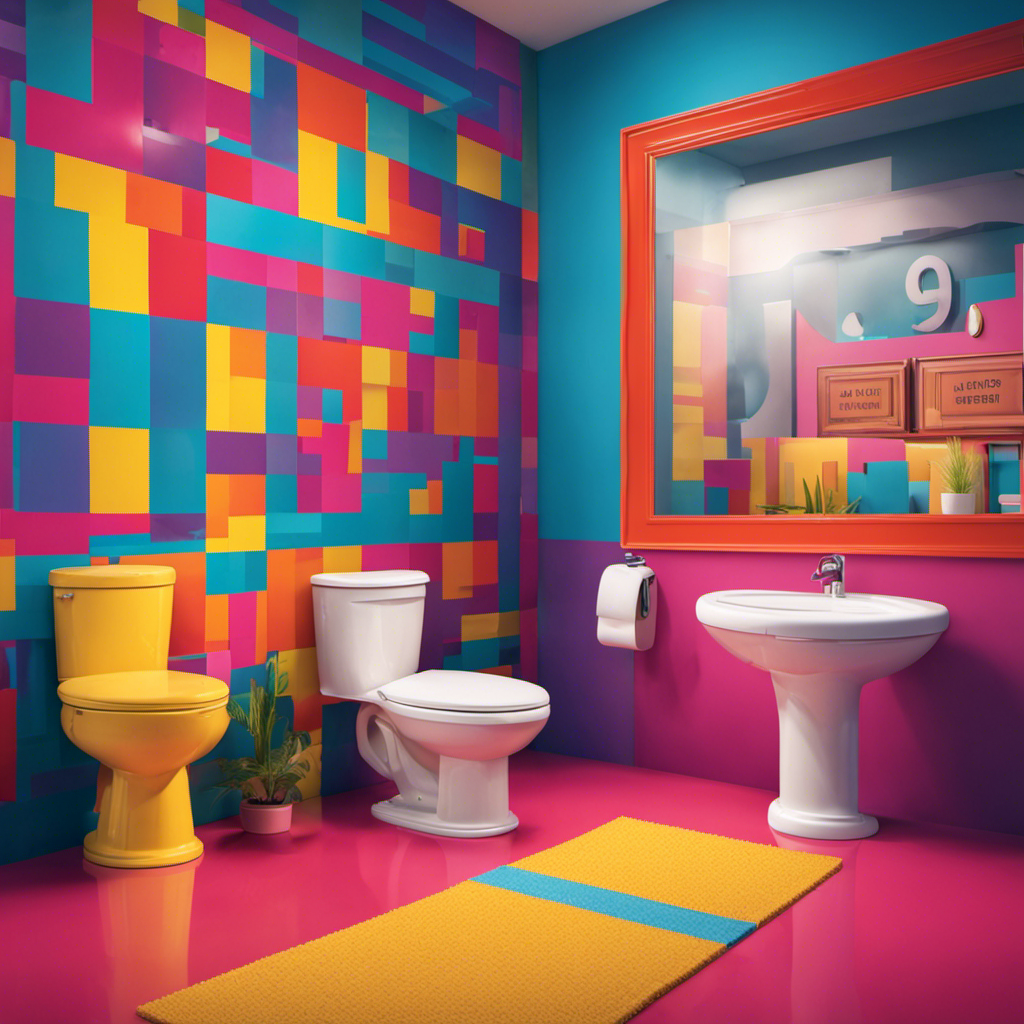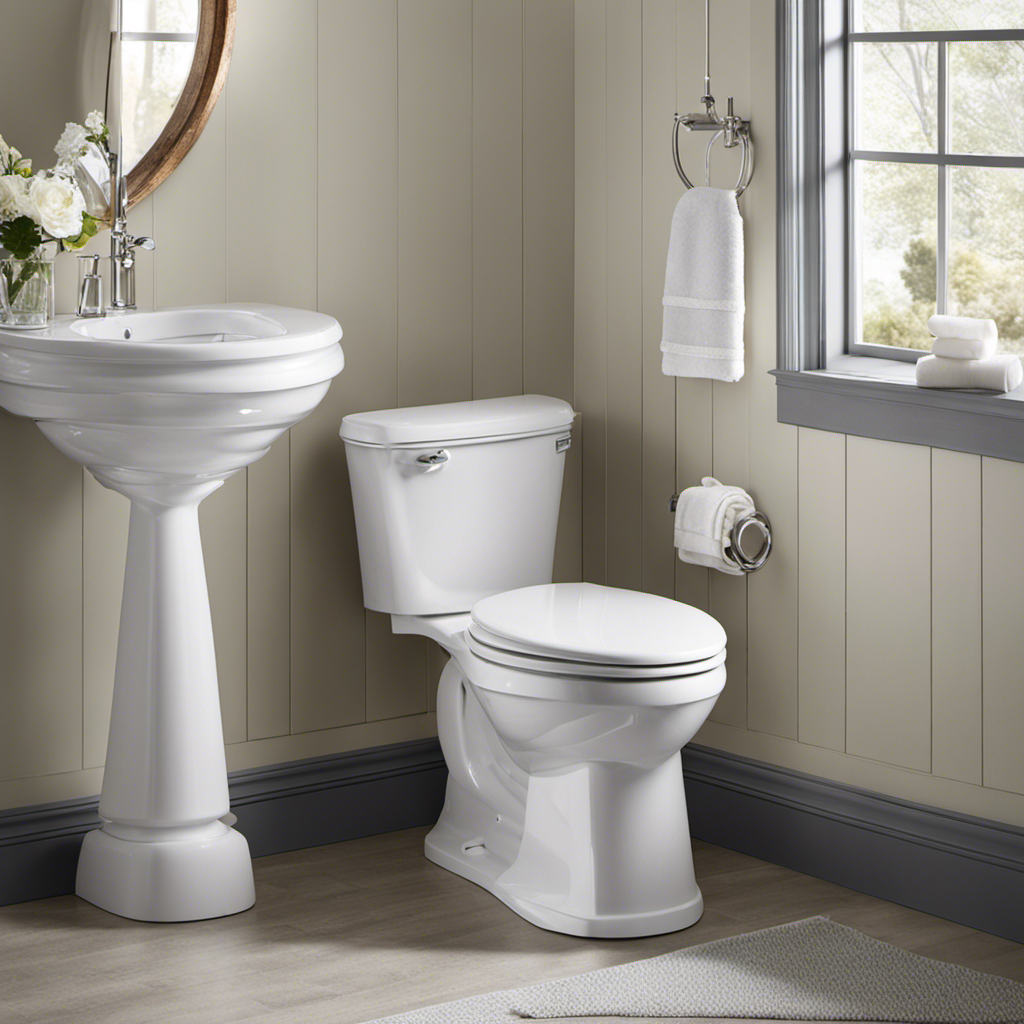I’ve been there, standing in a panic as I watched the water rise in the toilet bowl. It’s a situation that no one wants to deal with, but knowing how to stop a toilet from overflowing can save you from a messy and potentially costly disaster.
In this article, I’ll guide you through the causes of toilet overflow and provide you with step-by-step instructions on how to handle an overflowing toilet.
So, take a deep breath and let’s dive into the solution together.
Key Takeaways
- Regular maintenance and inspection can prevent toilet overflow issues.
- Avoid flushing non-flushable items to prevent clogs in the plumbing.
- Teach proper flushing technique to avoid overloading the toilet.
- Adjust the water level in the toilet tank as a preventative measure to avoid overflow.
Causes of Toilet Overflow
One of the main causes of toilet overflow is a clog in the plumbing. Clogs can occur when foreign objects, such as toilet paper, sanitary products, or excessive waste, get stuck in the pipes.
To prevent toilet overflow, it is important to be mindful of what you flush down the toilet. Avoid flushing items that are not meant to be flushed, like baby wipes or cotton balls.
Additionally, common toilet plumbing issues, such as a malfunctioning flapper valve or a faulty fill valve, can also lead to toilet overflow. Regular maintenance, such as checking for leaks, replacing worn-out parts, and ensuring proper water flow, can help prevent these issues and keep your toilet functioning properly.
Signs of an Overflowing Toilet
To avoid a potential mess, you can quickly identify signs that your toilet is about to overflow. It’s important to be aware of these signs so that you can take immediate action to prevent a messy situation. Here are some common signs that your toilet may be on the verge of overflowing:
-
Slow draining: If you notice that your toilet is draining slowly, it could be an early indication of a clog. This can lead to an overflow if not addressed promptly.
-
Gurgling sounds: Strange gurgling sounds coming from your toilet can indicate a blockage in the pipes. This can cause water to back up and overflow.
-
Rising water level: If you see the water level in your toilet bowl rising higher than normal after flushing, it’s a clear sign that an overflow is imminent.
To prevent these common toilet problems, there are a few prevention tips you can follow:
-
Avoid flushing non-flushable items: Make sure to only flush toilet paper and waste down the toilet. Flushing items like baby wipes, paper towels, or feminine products can lead to clogs.
-
Regular maintenance: Perform routine maintenance on your toilet, such as cleaning the jets and checking for any signs of wear and tear. This can help prevent clogs and other issues.
-
Don’t overload the toilet: Avoid flushing large amounts of toilet paper or excessive waste at once. This can overwhelm the toilet and increase the risk of an overflow.
Immediate Steps to Take When a Toilet Overflows
When your toilet starts spilling water onto the floor, it’s important to act quickly and turn off the water supply valve to prevent further damage.
Here are the steps to prevent a toilet overflow and common mistakes you should avoid.
First, locate the water supply valve, usually located behind or near the toilet. Turn the valve clockwise to shut off the water flow.
Next, remove the tank lid and lift the flapper valve to stop the water from flowing into the bowl.
If the water continues to rise, use a plunger to unclog the toilet. Avoid using chemical drain cleaners as they can damage your pipes.
Lastly, if the toilet doesn’t stop overflowing, call a plumber immediately to avoid any further damage.
DIY Methods to Stop Toilet Overflow
If your toilet is spilling water onto the floor, you can quickly prevent further damage by locating and turning off the water supply valve. Here are some prevention techniques for toilet overflow and common mistakes that can lead to it.
-
Regular maintenance: Inspect your toilet regularly for any signs of leaks or cracks. Replace worn-out parts, such as the flapper or fill valve, to prevent potential issues.
-
Avoid flushing foreign objects: Only flush toilet paper and waste down the toilet. Flushing items like wipes, feminine hygiene products, or paper towels can clog the pipes and cause overflow.
-
Proper flushing technique: Teach everyone in your household to flush the toilet correctly. Flushing excessive amounts of toilet paper or flushing multiple times in quick succession can overwhelm the system and lead to overflow.
-
Adjust water level: Ensure that the water level in your toilet tank is set correctly. If it’s too high, it can easily overflow. Adjust the fill valve to maintain the appropriate water level.
When to Call a Professional Plumber for Toilet Overflow
If you notice persistent water leakage and are unable to fix it yourself, it may be time to call a professional plumber for assistance with your toilet. While DIY methods can be effective in many cases, there are certain situations when it is best to leave it to the experts. Calling a professional plumber ensures that the issue is properly diagnosed and resolved, preventing further damage and potential health hazards. Common mistakes to avoid when trying to stop a toilet overflow include using excessive force on the flush handle, using chemical drain cleaners, and ignoring warning signs like slow drainage or strange noises. By calling a professional plumber, you can have peace of mind knowing that your toilet overflow problem will be handled safely and efficiently.
| Common Mistakes to Avoid |
|---|
| Using excessive force on the flush handle |
| Using chemical drain cleaners |
| Ignoring warning signs like slow drainage or strange noises |
Frequently Asked Questions
How Much Does It Cost to Hire a Professional Plumber for a Toilet Overflow?
Hiring a professional plumber for a toilet overflow can be costly. It’s important to compare the cost of DIY fixes versus hiring a plumber to determine the most cost-effective solution.
Can a Toilet Overflow Be a Sign of a Larger Plumbing Issue?
Yes, a toilet overflow can sometimes be a sign of a larger plumbing issue. It could indicate a clog in the drain line or a malfunctioning toilet mechanism.
Is It Normal for a Toilet to Overflow Occasionally, or Should It Never Happen?
Occasionally, toilets can overflow due to various causes. However, it is not normal and should be addressed immediately. By taking preventive measures such as regular maintenance, avoiding flushing non-flushable items, and adjusting water levels, you can minimize the risk of toilet overflow.
What Are Some Common Mistakes People Make When Trying to Fix a Toilet Overflow Themselves?
Common mistakes when fixing a toilet overflow include using too much force, forgetting to turn off the water supply, and not properly addressing the blockage. Follow these troubleshooting tips for a successful DIY fix.
Are There Any Preventive Measures to Avoid a Toilet Overflow in the Future?
To avoid a toilet overflow, there are preventive measures you can take. By regularly inspecting the toilet, checking water levels, and avoiding flushing excessive toilet paper or foreign objects, you can minimize the risk of overflow.
Conclusion
In conclusion, stopping a toilet from overflowing can be a simple task with the right knowledge and quick actions.
By identifying the causes and recognizing the signs of an overflowing toilet, you can take immediate steps to prevent further damage.
DIY methods such as using a plunger, turning off the water supply, or using a wet/dry vacuum can effectively stop the overflow.
However, if the problem persists or if you are unsure, it’s always best to call a professional plumber for assistance.
Interestingly, statistics show that toilet overflow is one of the most common plumbing emergencies, with over 30% of households experiencing it at least once.










